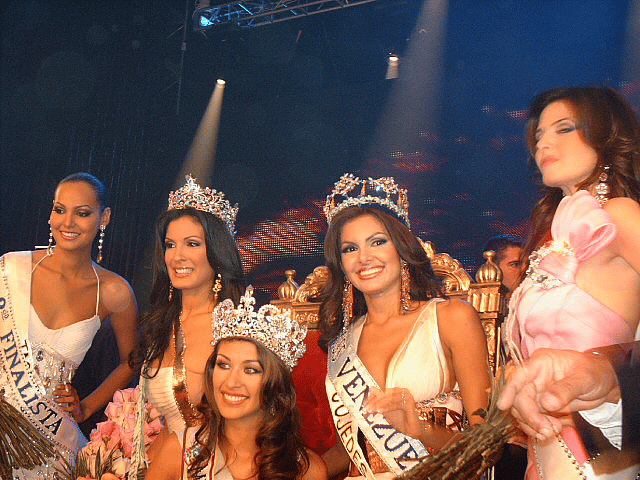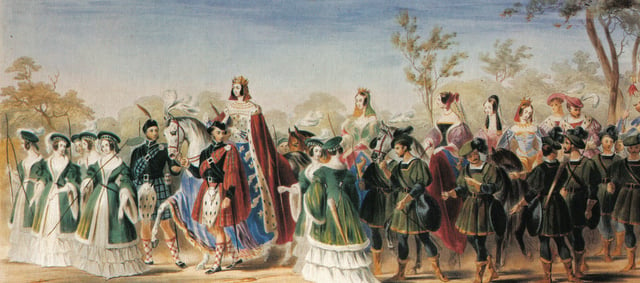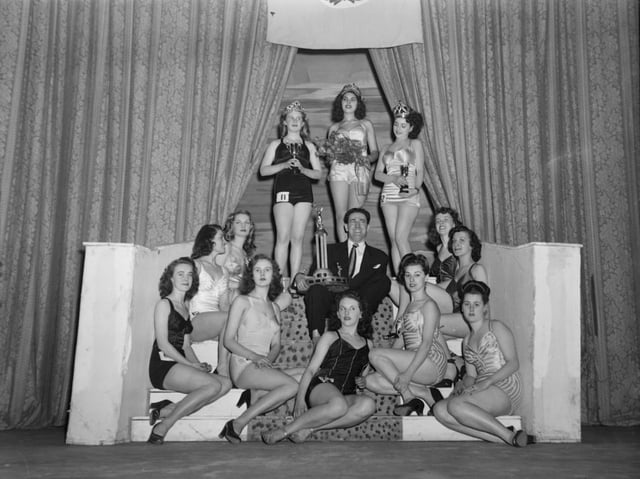Beauty pageant

Beauty pageant
A beauty pageant or beauty contest is a competition that has traditionally focused on judging and ranking the physical attributes of the contestants, although most contests have evolved to also incorporate personality traits, intelligence, talent, and answers to judges' questions as judged criteria. The term refers largely to contests for women such as the Big Four international beauty pageants.
The organizers of each pageant may determine the rules of the competition, including the age range of contestants. The rules may also require the contestants to be unmarried, and be "virtuous", "amateur", and available for promotions, besides other criteria. It may also set the clothing standards in which contestants will be judged, including the type of swimsuit.
Beauty pageants are generally multi-tiered, with local competitions feeding into the larger competitions. For example, the international pageants have hundreds or thousands of local competitions. Child beauty pageants mainly focus on beauty, gowns, sportswear modelling, talent, and personal interviews. Adult and teen pageants focus on makeup, hair and gowns, swimsuit modelling, and personal interviews. A winner of a beauty contest is often called a beauty queen. The rankings of the contestants are referred to as placements.
Possible awards of beauty contests include titles, tiaras or crowns, sashes, scepters, savings bonds, scholarships, and cash prizes. Some pageants award college scholarships, to the winner or multiple runners-up.[1]
History
Early years

Georgiana Seymour, Duchess of Somerset was crowned the 'Queen of Beauty' at the Eglinton Tournament of 1839, the first known beauty pageant

Woman receiving an award for winning a beauty pageant, 1922

Lone Star State Selects Beauties for 100 Year Pageant[2]
European festivals dating to the medieval era provide the most direct lineage for beauty pageants. For example, English May Day celebrations always involved the selection of a May Queen. In the United States, the May Day tradition of selecting a woman to serve as a symbol of bounty and community ideals continued, as young beautiful women participated in public celebrations.[3]
A beauty pageant was held during the Eglinton Tournament of 1839, organized by Archibald Montgomerie, 13th Earl of Eglinton, as part of a re-enactment of a medieval joust that was held in Scotland. The pageant was won by Georgiana Seymour, Duchess of Somerset, the wife of Edward Seymour, 12th Duke of Somerset, and sister of Caroline Norton, and she was proclaimed as the "Queen of Beauty".[4]
National pageants
Beauty contests became more popular in the 1880s. In 1888, the title of 'beauty queen' was awarded to an 18-year-old Creole contestant at a pageant in Spa, Belgium. All participants had to supply a photograph and a short description of themselves to be eligible to enter and a final selection of 21 was judged by a formal panel.[7] Such events were not regarded as respectable. Beauty contests came to be considered more respectable with the first modern "Miss America" contest held in 1921.[8]
The oldest pageant still in operation today is the Miss America pageant, which was organized in 1921 by a local businessman as a means to entice tourists to Atlantic City, New Jersey.[9] The pageant hosted the winners of local newspaper beauty contests in the "Inter-City Beauty" Contest, which was attended by over one hundred thousand people. Sixteen-year-old Margaret Gorman of Washington, D.C. was crowned Miss America 1921, having won both the popularity and beauty contests, and was awarded $100.[10]
International pageants
In May 1920, promoter C.E. Barfield of Galveston, Texas organized a new event known as "Splash Day" on the island. The event featured a "Bathing Girl Revue" competition as the centerpiece of its attractions.[11][12][13][14] The event was the kick-off of the summer tourist season in the city and was carried forward annually. The event quickly became known outside of Texas and, beginning in 1926, the world's first international contest was added, known as the International Pageant of Pulchritude.[13] This contest is said to have served as a model for modern pageants.[14][15][16] It featured contestants from England, Russia, Turkey, and many other nations and the title awarded at the time was known as "Miss Universe".[14][17] The event was discontinued in the United States in 1932 because of the Depression (the international competition was revived briefly in Belgium).
After World War II

Beauty contest in Montreal, 1948
The popularity of the Miss America pageant prompted other organizations to establish similar contests in the 1950s and beyond. Some were significant while others were trivial, such as the National Donut Queen contest. The Miss World contest started in 1951, Miss Universe started in 1952 as did Miss USA. Miss International started in 1960. Miss Asia Pacific International which started in 1968 is the first and oldest beauty pageant in Asia.[18][19] The Miss Black America contest started in 1968[20] in response to the exclusion of African American women from the Miss America pageant. The Miss Universe Organization started the Miss Teen USA in 1983 for the 14-19 age group. Miss Earth started in 2001, which channels the beauty pageant entertainment industry as an effective tool to actively promote the preservation of the environment.[21][22] These contests continue to this day.
Swimsuit competition
The requirement for contestants to wear a swimsuit was a controversial aspect of the various competitions. The controversy was heightened with the increasing popularity of the bikini after its introduction in 1946. The bikini was banned for the Miss America contest in 1947 because of Roman Catholic protesters.[23] When the Miss World contest started in 1951, there was an outcry when the winner was crowned in a bikini. Pope Pius XII condemned the crowning as sinful,[24][25] and countries with religious traditions threatened to withdraw delegates.[26] The bikini was banned for future and other contests. It was not until the late 1990s that they became permitted again,[9] but still generated controversy when finals were held in countries where bikinis (or swimsuits in general) were socially disapproved.[9][27] For example, in 2003, Vida Samadzai from Afghanistan caused an uproar in her native country when she participated in the Miss Earth 2003 contest in a red bikini.[28][29] She was condemned by the Afghan Supreme Court, saying such a display of the female body goes against Islamic law and Afghan culture.[30][31] In 2013, the swimsuit round of the Miss World contest was dropped because of Islamist protests in Bali (Indonesia), where the contest took place.[27] In 2014, the Miss World contest eliminated the swimsuit competition from its pageant.[32]
In 2017, Carousel Productions was criticized of objectifying women during the Miss Earth 2017 competition where delegates wore swimsuits during the event with their faces concealed by a veil in the Beauty of Figure and Form, a segment first introduced in the Miss Philippines Earth 2017 pageant.[33][34][35][36] It was one of the three preliminary judging segments of the pageant that include Poise and Beauty of Face and Environmental and Intelligence Competition.[37][33] The organizers defended the "beauty of figure and form" segment and released a statement that the said round was intended to promote strict impartiality during pre-judging by focusing on the contestants' curves, execution and not beautiful face.[38][34]
Major beauty pageants
The term "beauty pageant" refers largely to contests for women.[39][40][41] Major international contests for women include the yearly Miss World competition (founded by Eric Morley in 1951), Miss Universe (founded in 1952), Miss International (founded in 1960), and Miss Earth (founded in 2001 with environmental awareness as its concern).[42][43][44] These are considered the Big Four pageants, the four largest and most famous international beauty contests for single or unmarried women.[45][46]
| Founded | Pageant | Organizer | Location | Bikini allowed | Bikini regulation |
|---|---|---|---|---|---|
| 1921 | Miss America | Miss America Organization[9] | Atlantic City, New Jersey | 1997–2017 | 1947: Bikinis were outlawed because of Roman Catholic protesters.[23] 1997: Contestants allowed to wear bikinis.[9] 2018: Swimsuit segment of the pageant was dropped.[47] |
| 1951 | Miss World | Eric Morley, Miss World Organization | London, England | 1951–present | 1951: The first winner Kiki Håkansson from Sweden was crowned in a bikini. Countries with religious traditions threatened to withdraw delegates,[26] and Pope Pius XII condemned the crowning as sinful.[24][25] 1952: Swimsuits toned down to more modest designs.[9] 1996: Miss World contest was held in Bangalore, India, but the swimsuit round was shifted to Seychelles because of intense protests.[48] 2013: The swimsuit round was dropped because of Islamist protests in Bali, Indonesia, where the contest took place.[27] 2015: The Beach Fashion segment of the pageant was dropped.[49] |
| 1952 | Miss Universe | William Morris Endeavor | New York City | 1997–present | 1952: Bikinis banned. 1997: Contestants allowed to wear bikinis.[9] |
| 1960 | Miss International | International Cultural Association | Tokyo, Japan | 1960–present | 1964: Bikinis made mandatory |
| 1983 | Miss Teen USA | William Morris Endeavor | New York City | 1997–2015 | 1983: Bikinis banned. 1997: Contestants allowed to wear bikinis.[9] 2000: Tankinis were provided as an option for the first (and only) time.[9] 2016: Bikini competition was removed and replaced with athletic wear[50] |
| 1993 | Miss Teen International | International Cultural Association | Costa Rica | ||
| 2001 | Miss Earth | Carousel Productions | Quezon City, Philippines | 2003–present | 2003: Vida Samadzai from Afghanistan participating in a bikini caused an uproar in her native country.[51][52][53] 2017: The "Beauty of Form and Figure" preliminary judging in Miss Earth 2017 was introduced where the delegates walked in white two-piece bikinis but their faces were covered by a white veil to focus the judgment on the body figures on this portion.[54][55] |
Diversity
Besides the international beauty pageants, numerous minor competitions exist throughout the world displaying the different perceptions of beauty. Some examples of criteria to select beauty queens that are unique to certain cultures include the Indian history and traditional craft skills in the Miss Indian American pageant,[56] Indian dress section in the Miss India USA pageant[57] and the principles of "black beauty" that became accepted in the Miss Howard University competition.[58] The winner is often viewed as a model for the "ideal" community member.[59] Through the competitions, the contestants can learn how to present themselves in public and how to cultivate certain traits such as confidence or poise.[60] In some cases, the competitors are selected to act as a representative on behalf of the community. In the African American community of Howard University, the selected Miss Howard University served as advocates for the Civil Rights Movement in the decades following the 1960s.[58] Additionally, the Miss Landmine competition situated in Angola allow victims to serve as advocates on behalf of other victims of mining accidents.[61]
Researchers suggest that the emergence of beauty pageants in countries outside the United States is linked to an economic boom geared towards a more consumeristic lifestyle. For example, in India, from 1996 to 2000, the personal care industry grew by 25% while the number of women applying for the Miss India competition increased from 1000 people in 1993 to 6500 people in 2001.[62] Additionally, after China hosted about 6 international beauty pageants in 2004, the beauty industry increased in influence in the area. At the same time, the number of regional beauty pageants in the country increased.[63]
Benefits
Increased exposure for personal and professional endeavors, gain personal development skills through coaching and preparation, acquire opportunities to communicate your vision and goals efficiently and concisely, and have the ability to inspire others to believe in themselves with your confidence and determination to be successful. Pageantry also teaches you how to handle stress by learning to deal with pressure and disappointments.
Criticism

The panel of judges for the 1973 Miss Amsterdam pageant
Critics of beauty pageants argue that such contests reinforce the idea that girls and women should be valued primarily for their physical appearance, and that this puts tremendous pressure on women to conform to conventional beauty standards by spending time and money on fashion, cosmetics, hair styling, and even cosmetic surgery. They say that this pursuit of physical beauty even encourages some women to go on a diet to the point of harming themselves.[64][65][66]
The London Feminist Network argues that rather than being empowering, beauty pageants do exactly the opposite because they deny the full humanity of women by placing them as the subject of objectification; they reinforce the idea that a woman's only purpose is to look attractive.[67]
Another criticism that is placed on beauty pageants is in the way beauty is quantifiably scored as highlighted by the "Myth of the Perfect 10".[68] Beauty becomes a numerical coefficient in ranking contestants, and this type of scoring still remains followed as a system even in nationwide beauty pageants such as Miss America.[69]
Researchers suggest that these events strengthen skills, such as interpersonal communications, self-assurance, and public speaking, which prove to be useful in future career paths.[70]
See also
List of beauty queen-politicians
Swimsuit competition
